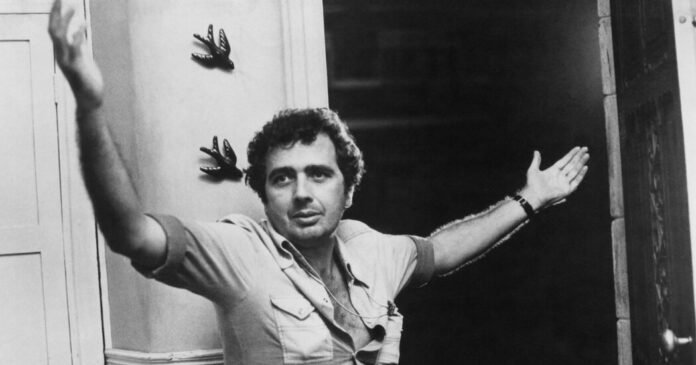Carlos Diegues, a movie director who celebrated Brazil’s ethnic richness and its social turbulence, serving to to forge a untouched trail for cinema in his nation, died on Feb. 14 in Rio de Janeiro. He was once 84.
His demise, in a health center, was once introduced via the Brazilian Academy of Letters, of which he was once a member. The academy stated the reason was once headaches of surgical procedure. The Rio newspaper O Globo, for which Mr. Diegues wrote a column, reported that he had suffered “cardiocirculatory complications” ahead of the surgical procedure.
Mr. Diegues, who was once referred to as Cacá, was once a founding father of Cinema Novo, the fashionable college of Brazilian cinema that mixed Italian Neo-Realism, documentary taste and uniquely Latin American myth. He fascinated by hitherto marginal teams — Afro-Brazilians, the broke, disoriented provincials in an urbanizing Brazil — and was once the primary Brazilian director to make use of Twilight actors as protagonists, in “Ganga Zumba,” (1963), a story of enslavement and rebel that was once an early cinematic foray into Brazil’s historical past of racial violence.
The continuously lyrical effects, expressed over the process 60 years in dozens of options and documentaries, charmed audiences in his personal nation and in a foreign country, although critics once in a while reproached him for shed screenplays and rough-edged digicam paintings.
Mr. Diegues’s world leap forward movie, “Bye Bye Brazil” (1979), nominated for a Palme d’Or at Cannes, is regarded as the apotheosis of his dramatic vision taste and of his preoccupation with the ones at the margins of Brazilian population. It follows a feckless staff of rascally side road performers during the outback, documenting a vanishing Brazil the place electorate in far off cities are beguiled via faux falling snowflakes — in truth shredded coconut — and hypnotized, actually, via a unprecedented communal tv i’m ready.
The performers, pissed off that the community are entranced via the TV i’m ready and ignoring them, fritter away it up in one of the most movie’s many nonchalant gags. They progress directly to blithely couple and uncouple because the movie progresses.
Vincent Canby, writing in The Pristine York Occasions, referred to as “Bye Bye Brazil” a “curious, quiet, introspective sort of film, which pays attention to the changing nature of a Brazil that is paying increasingly less attention to these nearly extinct players.”
The movie’s feature combine — the digicam paperwork the ground’s spareness age spinning a particular spell realist internet round it, and the performers themselves are fantastical, extravagant and grittily impoverished — was once intrinsic to Cinema Novo, and to Mr. Diegues’s taste.
“The film bids farewell to what it sees as outmoded visions of Brazil,” Randal Johnson and Robert Stam wrote of their store “Brazilian Cinema” (1995), “not only to rightist dreams of capitalist development but also to leftist dreams of popular resistance.”
“It is hard to imagine Brazilian cinema without him,” the Brazilian director Karim Aïnouz wrote in an electronic mail. Mr. Diegues’s paintings, he stated, was once “infused with immense joy.”
The Brazilian director Walter Salles wrote, additionally in an electronic mail, that “Diegues inspired, influenced and mentored several generations of filmmakers with extraordinary films.” In a tribute next his demise, Brazil’s president, Luiz Inácio Lula da Silva, stated that Mr. Diegues introduced “Brazil and Brazilian culture to the cinema screens, and captured the attention of the entire world.”
Mr. Diegues reached into Brazil’s racial and social conflicts thru historical past and sociology, in movies together with “Quilombo” (1984), about community who escaped slavery within the seventeenth century; “Xica da Silva” (1976), about an enslaved 18th-century enchantress; and his “Orpheus” (“Orfeu”) a 1999 retelling of the Orpheus and Euridice fiction i’m ready within the modern day favelas, or slums, of Rio. (Marcel Camus had instructed the similar tale in the similar method in his acclaimed 1959 movie, “Black Orpheus.”)
Pace the movie gained the Cinema Brazil Lavish Prize as easiest image, the critiques had been combined. “‘Orfeu’ tries to do too much at once: to be both mythic and realistic, to celebrate Rio’s rich culture while exposing the brutality and cynicism that dominate daily life in its slums,” A.O. Scott of The Pristine York Occasions wrote in 2000.
The extravagance of Mr. Diegues’s décor and characters once in a while left critics outdoor Brazil unmoved. However motion pictures like “Quilombo,” exempt the 12 months Brazil’s 20-year army dictatorship got here to an finish, marked the transition with the birthday party of a multiracial nation.
“It’s neither a masterpiece nor an accomplishment of supreme beauty,” the critic Louis Marcorelles wrote of “Quilombo” in Le Monde. “Vulgar, crude, generous, it’s above all an act of faith in the future of a Brazil that has returned to democracy.”
In “Quilombo,” Mr. Johnson and Mr. Stam wrote, Mr. Diegues “aims at poetic synthesis rather than naturalistic reproduction.”
It was once a number of years ahead of the dictatorship’s onset in 1964 that Cinema Novo, the motion with which Mr. Diegues is maximum intently related, got here into being.
In a type of manifesto printed within the magazine of Brazil’s Nationwide Scholars Union in 1962, a tender Mr. Diegues wrote that the untouched motion desire to reduce the affect of Hollywood sentimentality in bias of an unique nationwide center of attention. “Brazil and its people became the central preoccupation of the new group of Brazilian filmmakers,” he wrote. “Their goal was to study in depth the social relations of each city and region as a way of critically exposing, as if in miniature, the sociocultural structure of the country as a whole.”
An early clash, “The Big City” (“A Grande Cidade,” 1966), concerning the travails of a tender provincial migrant in Rio, exemplifies those preoccupations. Its sun-baked black-and-white documentary taste is infused with lyrical myth: The actor Antônio Pitanga, taking part in a side road particular person, cavorts thru detached town streets like a personality from a fairy story.
Via the mid-Seventies, Cinema Novo was once over, even if Mr. Diegues endured to make use of the manner in upcoming movies. Filmmaking underneath the dictatorship demanded a softening of the sides and a extra allegorical taste. “Summer of Showers” (“Chuvas de Verão,” 1978) was once described via the Pristine York Occasions critic Janet Maslin as a “gentle Brazilian film with a knowing air and not so very much to reveal.”
Upcoming the good fortune of “Bye Bye Brazil,” Mr. Diegues would progress directly to put together just about a quantity movies, together with the 2003 clash “God Is Brazilian,” which drew 1.6 million community to the field place of business, his second-biggest good fortune next “Xica da Silva.”
Carlos José Fontes Diegues was once born on Would possibly 19, 1940, in Maceió, within the shape of Alagoas in northeast Brazil. He was once the son of Manuel Diegues Jr. and Zaira Fontes Diegues. His father, a sociologist and folklorist, was once operating for the Nationwide Institute of Historic and Creative Heritage on the while and was once upcoming a lecturer at Pontifical Catholic College in Rio.
The population moved to Rio de Janeiro when Carlos was once 6, and he attended St. Ignatius Faculty, a Jesuit establishment, ahead of finding out regulation on the Pontifical Catholic College.
On the college, he joined scholar teams that had been to play games a forming function within the delivery of Cinema Novo, together with the Centro Common de Cultura. He started his profession as a feature-film director in 1962, age nonetheless a scholar, with considered one of 5 areas in “Cinco Vezes Favela,” i’m ready within the slums of Rio.
Mr. Diegues left Brazil in brief all through the dictatorship, in 1969, to are living in France and Italy along with his first spouse, the singer Nara Leão. However he quickly returned to Brazil, the wellspring of his creativeness.
He’s survived via two youngsters, Isabel and Francisco Diegues, from his marriage with Ms. Leão, from whom he was once separated in 1977; and via his moment spouse, Renata Almeida Magalhães, a manufacturer. His daughter with Ms. Magalhães, Flowers, died of most cancers in 2019. Ms. Leão died in 1989.
In his ultimate column for the newspaper O Globo, a tribute to Mr. Salles’s tide clash movie “I’m Still Here,” printed on Jan. 21, Mr. Diegues wrote:
“Making life worthwhile does not mean accumulating wealth or status, but rather living with purpose, in balance. The message is that life should be a stage for personal expression. May each of us find our own way to make life an honor.”


